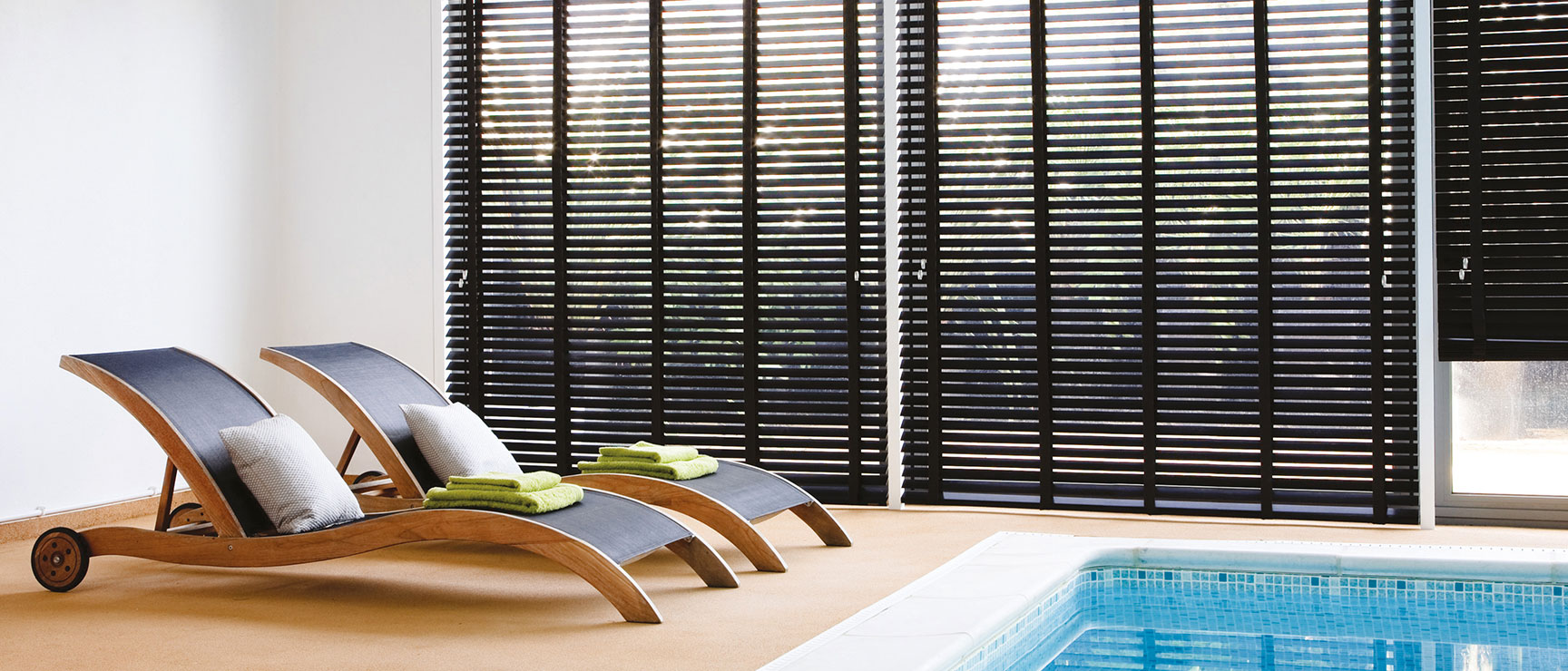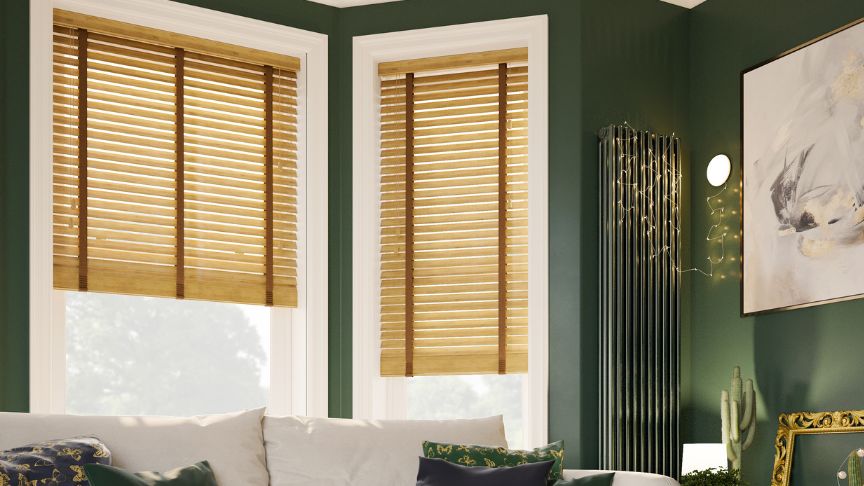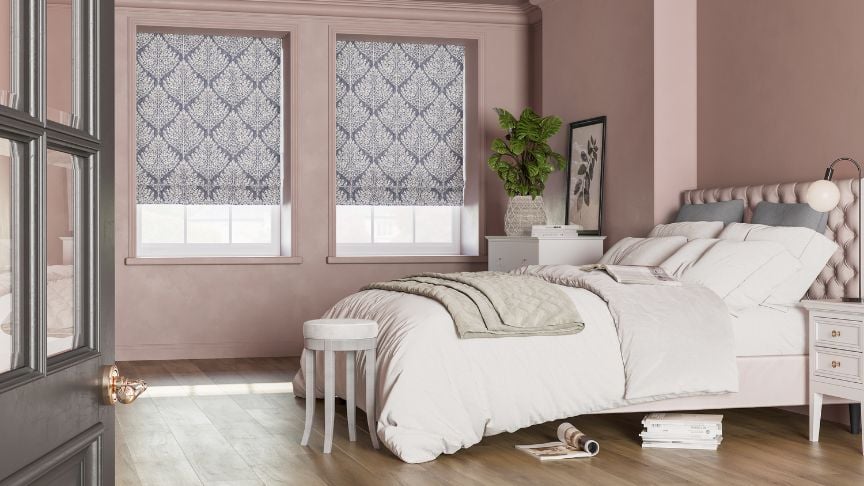So you're considering wooden blinds, and now you're wondering if faux wood blinds are better than real wood blinds. You'll want to know which is more expensive and if you can tell the difference, among other things.
Read on to find out our expert answers to the most common questions, scenarios and points of comparison.
- Faux wood vs wooden blinds: Cost
- Faux wood vs real wooden blinds: Installation ease
- Faux wood vs real wooden blinds: Look and feel
- Faux wood vs real wooden blinds: Material and environmental impact
- Faux wood vs wooden blinds: Durability
- Faux wood vs wooden blinds: Sizing
Faux wood vs real wooden blinds: Cost
In our article titled how much are wooden blinds, we break down the cost of wooden blinds. Whether you are looking at ready-made or made-to-measure, we've covered every price point.
We found that faux wood blinds are cheaper than real wooden blinds. Here's a comparison of the prices at different window sizes:
| Window Size | Dimensions | Faux Wood Cost* | Real Wood Cost* |
| Small Window | 45 x 70 cm | £37.70 | £46.57 |
| Medium Window | 90 x 110 cm | £52.24 | £69.86 |
| Large Window | 135 x 80 cm | £100.73 | £129.84 |
| Extra Large Window | 200 x 200 cm | £186.95 | £251.34 |
*Based on Swift Direct Blinds prices 11th November 2022.
Verdict: Faux wood is cheaper than real wood.
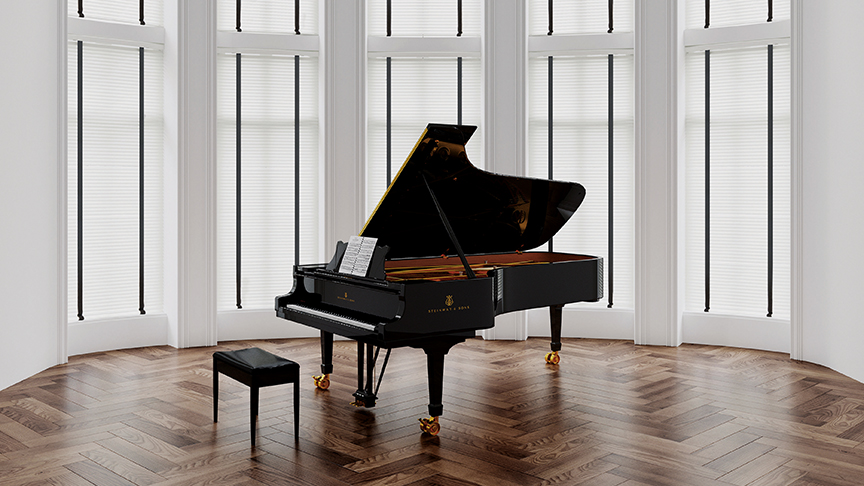
Faux wood vs real wooden blinds: Installation Ease
Installing both faux wood blinds and real wood blinds is a breeze, and the steps are pretty much the same for both kinds. It involves securing the wall brackets, fitting the blind headrail onto these brackets, and attaching the valance to complete the setup.
Real wood blinds are typically lighter in weight compared to faux wood blinds, which can make them easier to handle during installation.
For a detailed walk-through, don't miss our easy-to-follow guide on how to install wooden blinds.
Verdict:Real wood blinds might feel a tad lighter and hence a touch simpler to put up, but trust us, the setup process keeps things simple and uniform for both styles.
Faux wood vs real wooden blinds: Look and feel
The most hotly debated topic is whether faux wood achieves the same look and feel as the basswood we currently use for blinds.
Faux wood blinds have advanced in design, closely emulating the look and texture of real wooden blinds. Crafted from composite materials like PVC, they convincingly imitate the grain and colour variations of wood. While not identical, faux wood blinds offer a cost-effective option for achieving a similar aesthetic without the expense of genuine wood. On the other hand, real wooden blinds possess authentic warmth and texture from natural wood and showcase unique grains.
Verdict: It's a tie; both look and feel great. The choice ultimately depends on whether you'd prefer a more economical alternative with a near-wood appearance or the genuine tactile and visual experience of real wood. We recommend ordering free samples to compare for yourself!
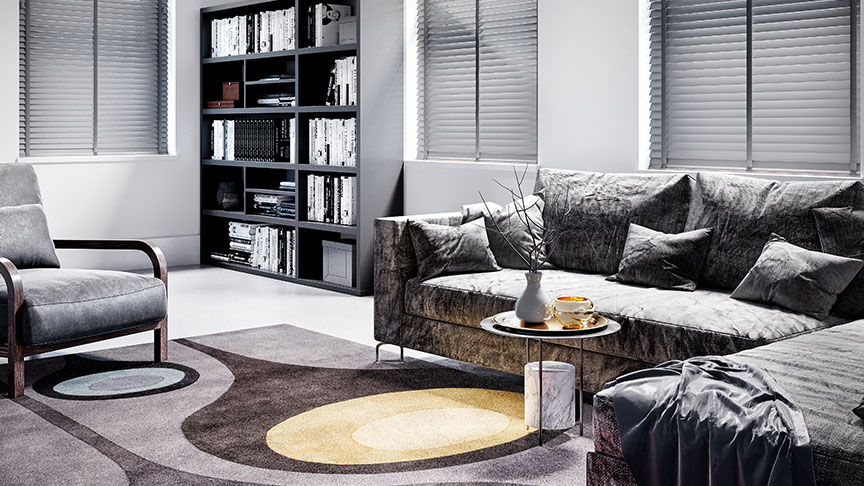
Faux wood vs real wooden blinds: Material and environmental impact
Climate change has highlighted the impact of carbon dioxide, plastics and various sustainability concerns. It's an intense debate, and there is nuance.
Let's start with real wood. Trees are renewable, and we manufacture blinds with a variety of hardwoods, such as the fast-growing basswood. It's a deciduous tree that produces light but durable timber. It absorbs carbon throughout its lifetime, which is released when cut down.
Our faux wood blinds are made from rigid Polyvinyl Chloride (PVC). The result is a highly durable, long-lasting material that can help insulate a home. There are some concerns around the biodegradable nature of plastics.
We believe that both have advantages and disadvantages. However, our real wood blinds are from FSC certified suppliers, biodegradable, and positively contribute to the ecosystem throughout their lives.
Verdict: Real wood gets the upper hand.
Editor's Note:
We acknowledge that this issue is complex and new data is constantly pushing the conversation forward. We recommend researching further and finding a solution that works best for you.
Faux wood vs real wooden blinds: Durability
Both materials offer a long-lasting product, but faux wood has several advantages that make them ideal.
Britain has a more humid climate than continental Europe, with the average home between 30 - 60% relative humidity. Faux wood has low water absorption levels, making it resistant to dampness and mould.
If you choose a wood blind, you're more likely to experience warping and cracking, even when installed in rooms that you wouldn't ordinarily consider wet environments.
Verdict: With its waterproof properties, faux wood wins this one.
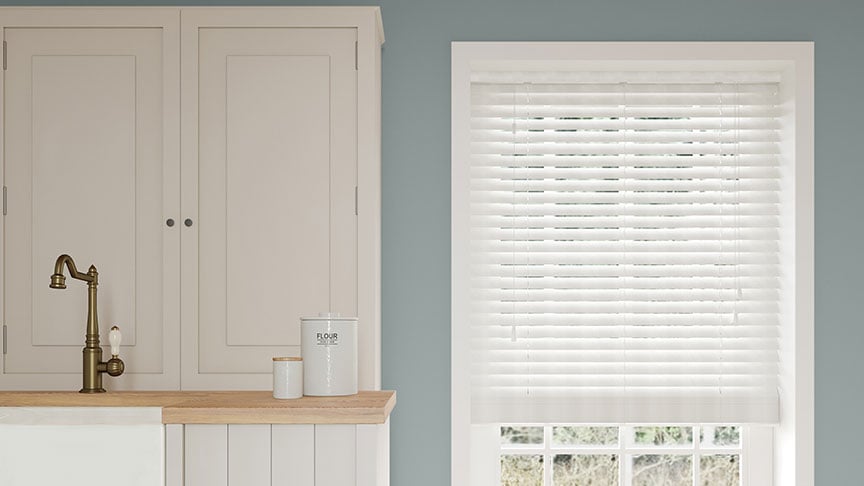
Faux wood vs wooden blinds: Sizing
If you're looking to order blinds for medium-sized or large-sized windows, you will want to order real wood blinds.
While the maximum width for both is approximately 240cm, faux wood is heavier than real wood and can't have as deep a drop. Since you will pull the cord to open fully, the weight will impact functionality and durability.
We also recommend splitting the blinds if the window is too large. You can find out more in our how to measure wooden blinds guide.
Verdict: Real wood blinds are better suited for large windows.
Pros and Cons - Faux wood vs real wooden blinds
Faux wood blinds offer cost-effectiveness, moisture resistance, and easy maintenance but can lack the authenticity of real wood.
Real wood blinds provide natural aesthetics, a wide range of finishes and are better suited for larger windows. However, they tend to be pricier and less resistant to moisture.
Faux wood blinds are better than real wood blinds for high moisture areas such as kitchens and bathrooms. Whereas for the rest of the home, both options are excellent choices for window coverings and have clear advantages and disadvantages, so it's up to you to choose whichever works best for you and your home.
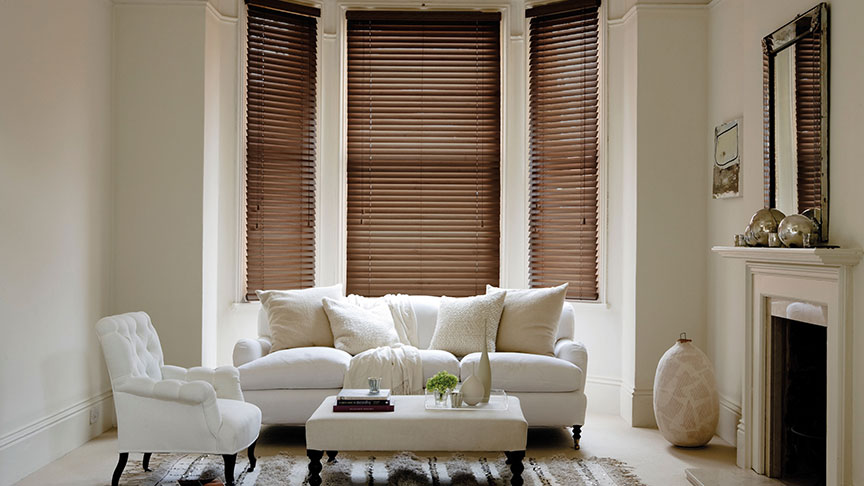
FAQ's
Do fauxwood blinds help insulate?
Yes, faux wood blinds can help provide some level of insulation for your windows. The PVC material faux wood blinds are crafted from possesses natural insulating qualities that aid in regulating the room's temperature to a certain degree.
When faux wood blinds are closed, they effectively establish a barrier between the indoor and outdoor air, minimising the transfer of heat through the window. Faux wood blinds can help retain heat during the winter months and prevent excessive heat from entering during the summer. However, it's worth noting that while faux wood blinds offer insulation benefits, their efficiency in this regard doesn't match up to specialised window treatments like cellular blinds or thermal curtains.
Are faux wooden blinds toxic?
Faux wood blinds are crafted from PVC, which can emit low levels of volatile organic compounds (VOCs). The health risks associated with exposure to the low levels of VOCs emitted by faux wood blinds are generally considered minimal, especially in well-ventilated spaces.
For individuals who prioritise safety or are particularly sensitive to VOCs, exploring blinds made from natural materials might offer peace of mind.
Which blinds are more prone to warping, faux wood or real wood blinds?
Real wood blinds are more prone to warping compared to faux wood blinds. This is primarily because real wood is a natural material that can be influenced by changes in humidity and moisture. When exposed to high levels of humidity or moisture, real wood blinds can absorb the moisture, causing them to swell, warp, or crack over time. This is especially true in areas like bathrooms or kitchens where humidity levels tend to be higher.
On the other hand, faux wood blinds are made from synthetic materials such as PVC, which are less affected by changes in humidity. As a result, they are more resistant to warping and are a better option for areas with higher moisture levels.
However, it's important to note that while faux wood blinds are more resistant to warping, they are not completely immune to it. Extreme heat or direct sunlight can still potentially cause some minor warping in faux wood blinds over time. Regular care and proper maintenance can help prolong the lifespan of both types of blinds and minimise the risk of warping.
Do faux wood blinds block light?
Faux wood blinds are not designed to be blackout blinds. While they can provide a certain level of light control, they do not entirely block out all light like dedicated blackout blinds.
The design of wood blinds, whether they are real wood or faux wood, includes slats that can be tilted to adjust the amount of light entering a room. When the slats are closed, they can significantly reduce the amount of sunlight entering the room, providing privacy and some light filtering. However, due to the nature of the materials and construction, there may still be some light seepage around the edges of the blinds and between the slats.
Can faux wood blinds be cut?
While it's technically possible to cut faux wood blinds to fit a specific window size, it's generally not recommended. Faux wood blinds are manufactured to specific dimensions, and altering their size by cutting them can potentially compromise their functionality and aesthetics.
Our faux wood blinds are tailored to fit your windows perfectly. This eliminates the need for cutting, as our blinds are customised to match your window dimensions accurately. By opting for made to measure blinds, you can ensure a seamless installation and maintain the blinds' intended look and functionality.
How do you clean faux wood blinds?
Cleaning faux wood blinds is a straightforward process that can keep them looking fresh and vibrant. Begin by closing the blinds to a flat position. Then, use a soft, microfiber cloth or a feather duster to gently remove dust and debris from the slats.
For a deeper clean, dampen a cloth with water and a mild soap solution and wipe each slat individually. Avoid excessive moisture to prevent warping. Once cleaned, tilt the slats upward to allow them to air dry. Remember to periodically clean the cords and mechanisms as well. Regular maintenance can help extend the life of your faux wood blinds and maintain their appearance.
Whether you choose faux wood or real wooden blinds, browse our full ranges today.
Browse Wooden BlindsLooking for more expert advice?
Take a look at our other expert guides.
